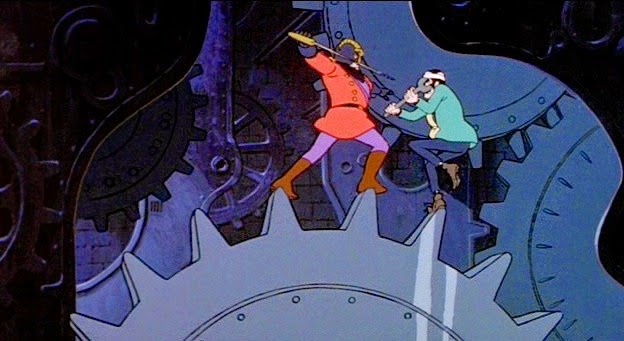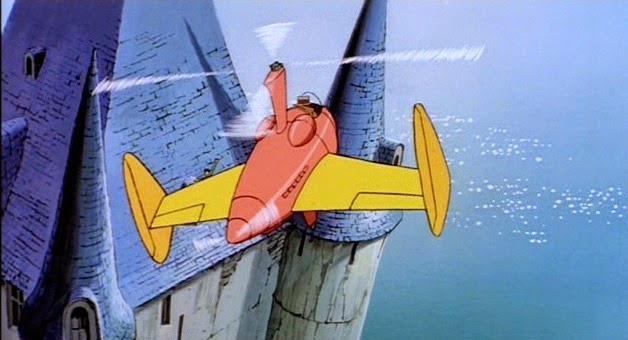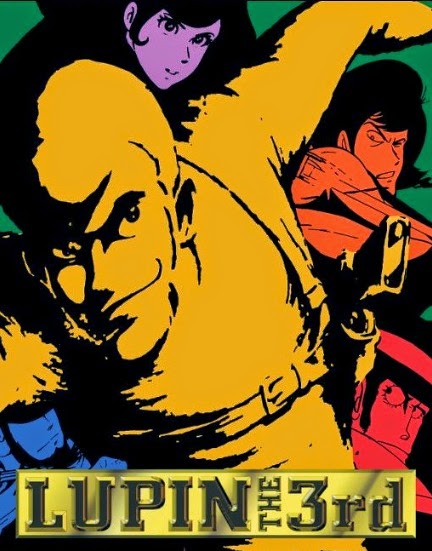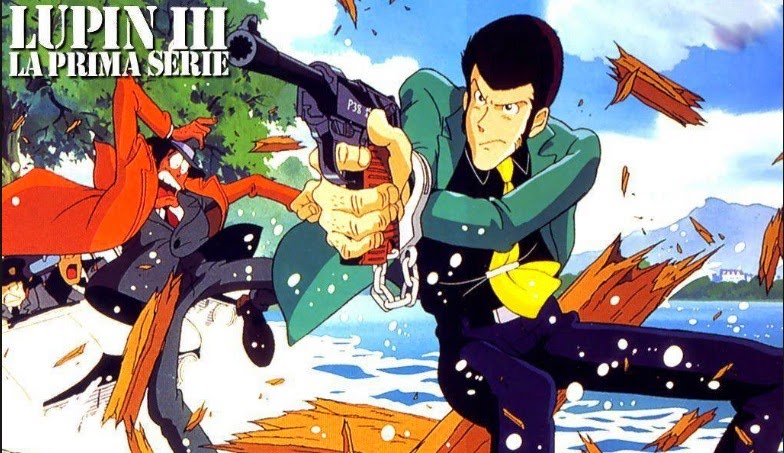Summary:
The episode kicks off with
another chapter of the serial thriller, The
Phantom Creeps. When we left our heroes they were plummeting in an airplane
thanks to the cute spider bomb used by Dr. Zorka (Bela Lugosi). Unfortunately
the crash kills Zorka’s wife and this fans the flames of his rage to do evil
deeds. His thuggish assistant Monk (Jack C. Smith) keeps putting the two of
them in more peril and Zorka must use all his gadgets including his invisibly
belt, walking bombs and his huge ugly robot to escape capture. The episode
contains a shoot out and ends with a car containing the bland detective
hurtling off a cliff thanks to Zorka’s ingenuity. Can the madman be stopped in
time?
The feature films starts with
the realization that Sputnik was just hurtled into space by those pesky
Soviets. America is caught with its pants down. No working ICBMs, heck no
working rockets at all! Much scrambling ensues to get something… anything up
into the air. As our scientists flail around (and presumably The Right Stuff occurs off screen) a
CIA agent is sent on a top-secret mission. His name is John White (John McKay)
and his job is to sneak into Russia, contact an undercover cutie in Moscow
named Tanya (Monica Davis). She’s “seeing” a Soviet general with information on
the space program. White discovers that the Soviets are planning to launch a
missile at New York! Now he must attempt to sabotage the missile and escape
from Russia. But does he have a hope in hell of preventing Rocket Attack U.S.A.?
Movie Review:
 |
| No matter how hard you try Joel, you can't climb out of the theater. |
Lugosi is hamming it up
still, and it works great. His interaction with his assistant Monk is
hilarious. Monk seems eager to help, but is just a bumbling guy. He nearly
blows them all up. We also get to see the robot at work - because he opens a
secret door and lumbers around some more. I was hoping to see him take out some
of the cops, but not in this episode. You also learn that Monk can take seven
or eight bullets, and he’s only stunned. And I thought the robot was tough!
As far as serials go, The Phantom Creeps continues to be
breezy fun, with a lot of completely convenient and silly things happening to
make the plot move forward, and Lugosi is around to keep it entertaining.
 |
| "The president called. He said you're the worst scientist ever." |
I’m afraid I have to go into
spoiler territory here to really write about this film, so SPOILER ALERT!!!!!! The sabotage attempt fails spectacularly
and the missile comes crashing down on New York. So at least you can say the
film lives up to its title.
 |
| Joel tries to convince her to stop dancing. |
Rocket Attack U.S.A. presents
a government flailing around to get a working rocket into the air. They want to
stall the Soviets into thinking we have some kind of ICBM ability. But time and
again the tests fail. I was strongly reminded of the montage from The Right Stuff when the various test
rockets fail in spectacular and silly ways. The budget to this film didn’t
allow for that kind of visual, but lengthy dialogue scenes between scientists
and government officials imply the failure.
 |
| Russian high command making a fateful decision. |
Since I brought him up, I
should tell you a bit more about the voice over. It is constant. The whole film
is aided by this domineering voice telling us the background to the events and
even commenting on the action. It’s like watching a Centron film about the
start of WWIII. In a way I can see how this was done to give Rocket Attack U.S.A. a documentary
feel. But at the same time it gets to be ridiculous. The voice won’t stop
talking and pointing out things that the visuals clearly show.
 |
| The scene that inspired "The Spy Who Love Me"? |
Anyway, he manages to get
into the least heavily guarded site in the entire Soviet Union, even though a top-secret
rocket is preparing for launch from there. He’s able to sneak right up to the missile
and plant his explosives. But he ends up getting detected at the last minute,
runs away and then gets himself shot. The explosives are removed and detonated
by a loyal soviet soldier in a suicide run (quite literally). So mission fail,
end of the movie, right?
 |
| Who the hell are these people? Dead meat! |
So yeah, that happens.
Rocket Attack U.S.A. is certainly a movie of its time. But it is also an
interesting attempt at honest to goodness fear mongering. It’s fascinating to
watch how the film attempts to manipulate the viewer, and by doing so goes in
unexpected directions. I’ve never seen a film of this era where the CIA and the
power of science in the United States are so impotent. Having the Russian high
command talk entirely in Russian is clever and surprising. Even the “we are all
dead meat” characters at the end of the movie are simultaneously ridiculous and
yet it almost works. It is a unique film in a lot of ways. But it really isn’t
a good one. The low budget hampers many scenes, especially the ones that play
out in Russia. The acting is uniformly weak (and downright bad at times). Much
the dialogue and voice over is unintentionally funny. It’s got a lot of
elements that make it perfect for Joel and the bots.
Episode Review:
 |
| That is a flaming tie. It took the crew at MST3K three viewings to figure that out. |
Well things get started off
well with The Phantom Creeps. Once
again the boys have a blast with imitating Lugosi and providing extra dialogue
for the befuddled henchman Monk. When Joel sees the opening title he asks the
bots, “Now is Creeps being used as a noun or a verb?” Good question, and one that
is never answered. Later when the grumpy robot is wandering around the lab,
Crow comments that “for a robot he has a flat butt.” He is certainly not as
curvy as Gypsy. I also got a chuckle out of a scene where the invisible Lugosi
picks up a tree branch and sneaks up on the detective. Joel says, “Walk
invisibly and carry a big stick!”
 |
| One of these three is not wearing pants. Guess who? |
So The Phantom Creeps gave us a durable callback riff, what does Rocket Attack U.S.A. give us? Well the
movie itself doesn’t move very fast, and that slow pace contrasts with the speed
of the serial. As is the case, the boys do a solid job, but I wish they pumped
up the energy just a bit more in the riff.
One element gives them plenty
to work with. The endless voice over commenting on the action is perfect for
them to just add additional lines or riff right back at. Some of the funniest
parts are little one-liners or words the boys add to the end of the narrator’s
lines.
 |
| CIA operative is spotted in about 14 seconds. It's a new record. |
 |
| The alien monolith observes the action. |
As the film heads into the
third act the music becomes very bombastic. Tom observes, “The music implies
something exciting is about to happen.” Crow replies with “The end of the
movie?” And when it is all said and done Crow observes that “I had no idea the
end of the world would be so boring.” Ah my metal friend, you haven’t seen Birdemic: Shock and Terror yet, have
you?
The host segments for Rocket Attack U.S.A. are an odd bunch.
Most of them have a funny core idea, but end up running way too long. This
movie must be really short. The episode starts with Joel giving Tom Servo a
haircut. Now his round clear dome is a narrow cylinder. This was done to
respond to some viewer feedback that Tom’s rounder head obscured too much of the
action on screen. Keep in mind this was only season two of the show, so they
were willing to give things like this a try. Tom’s haircut only lasted a couple
episodes before it returned to the round shape.
 |
| The tin foil fashions also protect from fallout. |
 |
| Monk and Zorka doubt the veracity of this movie. |
Still this movie did provide
us with one important piece of Mystery
Science Theater 3000 history. It contains the first stinger. The stinger
was a short segment from the film that was shown right after the end credits of
the episode rolled. It was usually a bizarre moment or dubious line read that
isolated from the film is even funnier. MST3K turned stingers into a comedic
art form and there were plenty of great ones through the years. This one
features the random blind man saying “Help me.” The stinger would go on to
inspire others. I’ve seen both the Nostalgia Critic and Obscuras Lupa add
stingers to the end of their reviews for one more laugh.
But even with the addition
of the stinger I can only give this episode three burning ties out of five.
This episode is available on
the Mystery Science Theater 3000
Collection: Volume XXVII.

























